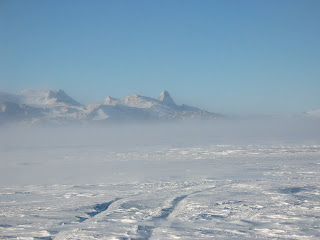Hello everyone,
Greetings from McMurdo. We are back in town after a successful expedition to our field camp in the Patriot Hills. We spent two weeks out there and got all of our stations installed - 5 seismic and 6 GPS. It was a great time and I have lots of pictures to go through and post. I'll be working on those over the next few days so there will be lots of updates in the near future. We have four stations left to install from McMurdo and then I will return home. Right now it looks like that will be sometime in mid-February. I look forward to seeing you all soon. Thanks for all the comments and keep them coming.
Here are some replies to the comments I have received so far.
Mark, Amy - I know I should be wearing a coat, but actually it is pretty warm a lot of the days at McMurdo (plusing I'm wearing some thermals under my outer layer so it is not so bad). When the sun is out and at its highest point and there is no wind, the temperature can get as high as 35-40F. However, when the sun is low and it is cloudy and the wind picks up it can get pretty cold, more like 15-20F. At most of our field sites it is considerably colder and I can assure that I wear my coat and multiple layers of thermal underwear out there. Also, as most of you know there is 24 hours of daylight here during the summer and 24 hours of darkness during the winter (It is summer in the southern hemisphere right now). So during the daytime hours the sun is a little higher in the sky so it gets a little warmer, and during the evening it gets a little lower so it gets cooler. But the sun won't set again here until late February. Until then it just spins around in the sky providing constant sunshine and some warmth. The main things that affect the temperature at a given location here are the elevation and the wind speed. Obviously, the higher you go, the colder it gets. McMurdo is on a island and located right at sea level so it is not so bad. Our field sites, however, range from about 1500 ft to 8500 ft above sea level. But the thing that really gets you is the wind. The winds here, known as katabatic winds, can be brutal and are the highest sustained winds recorded on earth. Sometimes as much as 200 mph! This occurs when air from the top of the frigid Antarctic ice sheet (also known as the polar plateau, elevation >10,000 ft, avg temp -30 to -50F) cools, loses density, and descends rapidly to lower elevations. There were some days at Patriot Hills where the wind would literally knock you over if you did not have a firm foothold in the ground. It was amusing trying to walk from one place to another during the katabatic winds because you would have to lean into the wind to make progress, but then the wind let up for a second and you would fall flat on your face!
Andy - Good to hear from you! I'm glad you found the blog. And you're right, everything is delicious compared to a chunk of pemmican! This place is just like scout camp for grown ups. I know all of our scouting buddies would love it here. Below is a picture of me enjoying one of those survival bars.


Kaare - Don't you worry, I've got lighters for all! And something else for you I know you like to collect.
Krystal - Stephanie, from the Glamour article, is a member of our field team. She is in the group picture of the deployment photos.
Michelle - Yes, that news article is about our group. Doug is my advisor at WashU. I think they're planning to run another story when we get back and I may get interviewed for it. The link for those of you that missed the previous article is
http://www.ksdk.com/news/news_article.aspx?storyid=135868Thanks for posting!
And speaking of news articles, here's another link to a news article from the New Zealand Press about the Basler crash with quotes from my blog!
http://www.stuff.co.nz/stuff/4335674a12.htmlBrian - I did not get a chance to participate in the Scott's hut run. I didn't find out about it until it was too late!
Ryan - Don't know if I'll get a chance to do some fly fishing or not. I looked into it on my way down and it is pretty expensive for license, transportation, gear, guide, etc. You know I'll be ready as soon as I get home though! Should be right in time for opening weekend too. I've got lunker fever!
Ok, that's all for now. Sorry if I missed your comment. I think some of them got deleted somehow. I have lots of pictures, maps, and other fun stuff that I'll be posting soon.




 These little tents are called clam shells. This is were we slept when we weren't working. They were pretty nice. There were mattresses and a small table inside and just enough room to stand up and change your clothes.
These little tents are called clam shells. This is were we slept when we weren't working. They were pretty nice. There were mattresses and a small table inside and just enough room to stand up and change your clothes.
















































